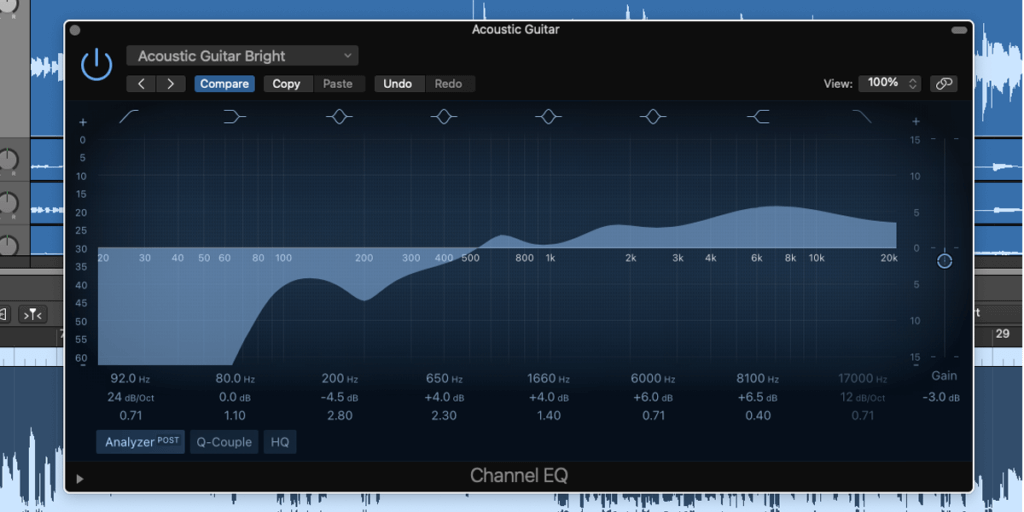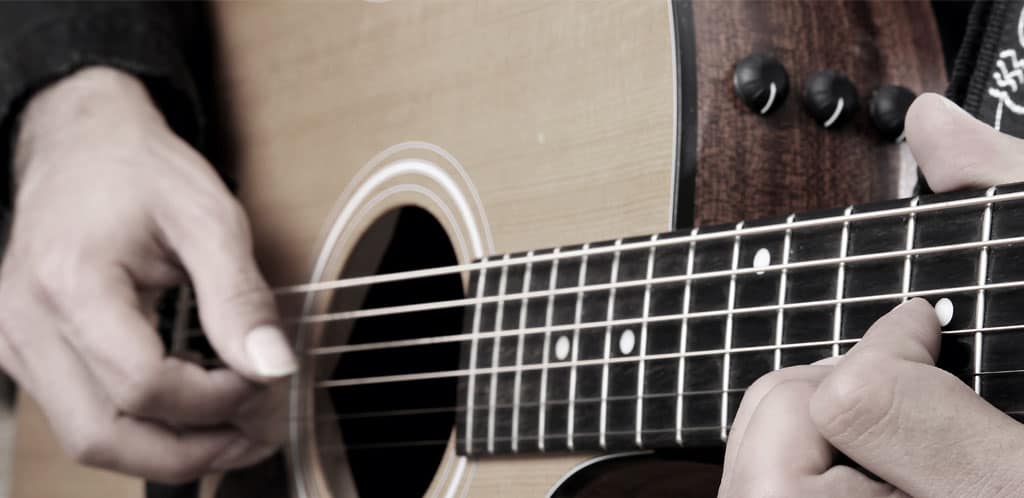In the following article, we’re going to discuss the characteristics of what makes a bright-sounding guitar string, taking into account the materials used along with string gauge and the brands that offer the brightest-sounding strings. But if you looking for a quick reference:
New, uncoated, 80/20 bronze, light gauge strings (12’s or lighter) sound brightest as they accentuate the upper mid, and high frequencies.
Ernie Ball Aluminum Bronze Acoustic Guitar Strings (uses aluminum oxide wrapping), D’addario 80/20 bronze, and Martin 80/20 bronze strings are known for producing a bright tone.
For a more in-depth explanation continue reading.
What is a Bright Tone?
In the majority of cases when a guitarist describes, a bright tone they are referring to an emphasis on the upper-mid to high-range frequencies.
In most cases, the main goal of “brightening” up a guitar’s tone is greater articulation.
Generally, a brighter tone provides greater note separation, and therefore clarity. Taken too far, however e.g. too much emphasis on the upper mids and highs will begin to sound harsh resulting in a more abrasive tone and a loss of clarity.
But, it’s important to remember tone is subjective.

If dialing in a bright tone using EQ you would likely reduce bass and boost the upper mid-range. The subjective part of the equation really comes back to how much of an adjustment to make.
Can Guitar Strings Really Make that much Difference?
‘Timbre’ (Tam-ber)
When we pluck a guitar string sound waves are produced which consist of a fundamental frequency (the lowest frequency), and a series of overtones.
Overtones are additional frequencies we hear along with the fundamental frequency. This occurs because guitar strings oscillate at more than just one frequency.

This combination of the fundamental and series of overtones is what gives an instrument its timbre or tonal quality.
The physical characteristics of a material e.g. density and hardness (stiffness) determine which frequencies are most accentuated.
For example, higher frequencies produce more rapid soundwaves e.g. more soundwave cycles per second but tend to lose energy quickly. Low-end frequencies produce longer soundwaves and take more energy to produce, and tend to sound warmer to our ears.
The characteristics of the strings you use in terms of density (materials used), tension (gauge of string) amongst other factors, affect the tonal response of the guitar in terms of the combination of fundamental and overtones.
Light V Heavy Gauge Strings
Heavier gauge strings e.g. 12’s and above, tend to accentuate low-end frequencies more than light gauge strings. This also creates additional volume and sustain.
This is because, as discussed above, low-end frequencies require greater energy to produce. The greater mass and tension of heavier gauge strings produce more energy than lighter gauge strings, which also explains why there is greater volume and sustain produced.
String Material
Acoustic guitar strings consist of a steel core with the 4 heaviest gauge strings (G, D, A, and low E strings) being wound in either 80/20 bronze or phosphor bronze for the most part.
Most guitar strings now use hexagonal (hex) cores and these tend to sound brighter due to their reduced mass compared to that of round core strings, which although still available today are less common.
With regard to the winding materials, 80/20 bronze (an alloy consisting of 80% copper and 20%) tends to offer a brighter tonality than 80/20 phosphor bronze which tends to sound marginally warmer.
New V Old Strings
Anyone that owns a guitar that’s overdue for a string change will know just how much much of a difference new strings can make in terms of brightness and clarity.
Guitar strings deteriorate due to the corrosive nature of our hands and build up with gunk e.g. sweat, dirt, and oils, and begin oxidizing. This not only causes physical changes to the strings in terms of density which result in a loss of volume, projection, and sustain, but the guitar will also begin to sound dull as the overtones produced by the guitar are impacted.
New strings, on the other hand, contain more energy and therefore produce greater resonance allowing the guitar to sound brighter and more articulate.
The Trade-Off
Under most circumstances, your guitar strings (irrespective of gauge, brand, or materials) will always sound brighter when new.
But strings begin deteriorating quickly unless you use a coated string e.g. Elixir. However, due to the coating, these strings are usually not as bright.
However, uncoated strings will age faster and begin sounding dull faster. So while not regarded as particularly bright-sounding, coated strings will sound moderately bright for longer, as the string won’t deteriorate as quickly.
The same can be said for round core v hex core strings. Hex cores tend to wear more quickly due to the edges of the hex shape.
In simple terms, unless you change your strings regularly, there is a trade-off in terms of brightness vs durability.
Our Recommendations
While there are a variety of 80/20 bronze guitar strings on the market, the three listed below tend to be most favored for producing a bright tone.



Other ways to increase brightness
Humidity Control
A guitar that is affected by a high-relative humidity e.g. the guitar is wet, will sound dull, and lack top end.
A relatively dry guitar is more resonant (the soundboard of the guitar moves more easily) and increases the upper mids and high frequencies as the wood is lighter.
Using a Different/Harder Guitar Pick
One of the simplest ways to increase brightness is to simply try either using a pick (if you play mostly with your fingers) or try a harder pick. Just as strings influence the resonance of an acoustic guitar due to the characteristics of the strings, guitar picks do much the same.
Harder Components
Harder, stiffer components e.g. brass endpins, bone nut, and saddle place a greater emphasis on the upper mids and highs producing a brighter tone.
Final Thoughts
Keep in mind, guitar tone is often about achieving balance. Those seeking brighter-sounding guitar strings, may not be looking to produce an excessively bright tone, but rather are trying to brighten up an overly warm-sounding guitar that lacks the clarity the guitarist desires.
For example, a set of Martin 80/20’s may help balance a darker-sounding guitar e.g. a guitar constructed from mahogany, or a larger body guitar such as a dreadnought.
The pairing of materials has a huge influence on tone and playing around with different combinations allows you to explore the tonal response of your guitar.
Of course, tone is subjective, it’s best to rely on your ears, rather than what you. might expect from a specific component or material, as your ears will always be the most honest judge of tone you have available.



